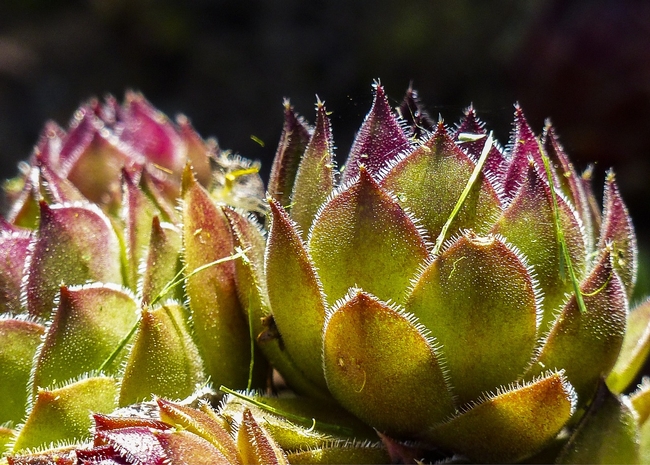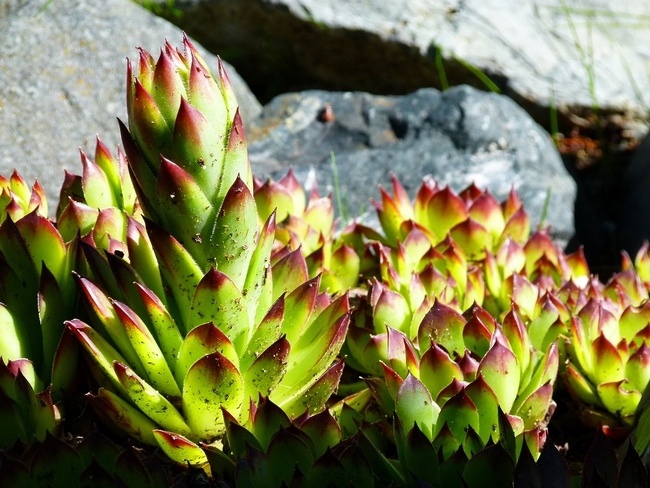When I was still living at home with my parents, I remember my mother loving the succulent known as hens and chicks (Sempervivum spp.). They were often planted along highways.
To be honest, I was not impressed with them. But today, I am very impressed. There are so many interesting succulents now, in a variety of colors, textures, sizes and shapes. And they come from so many different parts of the world. Since my childhood, the world of succulents has grown immensely.
A succulent is a plant that stores water in its leaves. That's why the leaves are so plump and fleshy.
They come from arid parts of the world, such as desert regions of Africa and Central America. And they include a large variety of types.
Succulents are ideal for Napa Valley gardens since we live in a drought-prone area. They look wonderful when planted with an eye to their varied colors and leaf shapes. They look good year-round while most conventional landscapes have moments—maybe weeks—when they are largely dormant and not looking their best.
A succulent garden is not the same as a cactus garden. All cacti are succulents because they store water in their leaves. But not all succulents are cacti.
Wikipedia says that succulents are “plants that are more than normally thickened and fleshy.” Their fleshy parts help them retain water in arid conditions. The name comes from the Latin word sucus, meaning "juice" or "sap." The water content of some succulent organs can reach 90 percent.
While some succulents can survive short periods of cold weather, most do not tolerate frost well. If you have potted succulents, move them to sheltered locations when frost threatens. If they're in the ground, cover them with tarps or blankets. If they are frostbitten, you may be able to save them by removing the damaged parts.
We had a terrible frost one year and it killed many of my succulents, probably because the soil was dry. I learned a lesson. Make sure your soil is damp when severe frost is predicted.
Propagating succulents is easy. They are eager to grow and can be propagated from leaf cuttings or stem cuttings.
When taking a leaf cutting, select a healthy leaf and cut it back to the stem. Choose a large pan, such as an oil-change pan with drainage holes drilled in it and fill it with a fast-draining soil mix. Succulents do not need a nutrient-rich soil, but they do require excellent drainage.
Let the cut leaves air-dry until they form a callus on the bottom, about 24 hours. Then either lay them on the soil or, as I do, place them upright so you can fit more in the pan.
For a stem cutting, cut a 3- to 4-inch piece with a healthy growing tip, cutting just above a leaf. Remove the lower leaves on the stem, leaving a cluster at the top. Let air-dry until a callus forms, 24 to 48 hours, then insert the stem into the soil. Some people like to dip the cut stem into rooting hormone to promote growth.
I have read that stem cuttings produce roots faster than leaf cuttings. I have seen a few long stems in my own succulent collection form roots along the stem while still attached to the plant.
If you are taking cuttings in hot weather, be sure to keep them in a shady place so they do not get sunburned. In the fall and winter, I propagate my cuttings in a passive-solar hothouse which is warmer than the outdoors. These baby plants require more water than mature plants so monitor often and keep the soil damp.
By either propagation method, it takes a few months for roots to form and for tip growth to resume. With a leaf cutting, eventually the original leaf will drop, and the new growth will take over. Once your cutting has roots, you can transfer the succulent to a growing pot.
Rather than dig up a plant that may or may not have roots, I gently tug on the stem and see what happens. Rooted cuttings will not move. If it does move, I wait a few weeks before giving another gentle tug. Not every cutting will root successfully so don't be discouraged.
The biggest pest problem I've encountered with most succulents is snails and slugs. I hand-pick them and also use snail bait to slow them down. My right foot has also been known to get involved.
My succulents are also blooming. The blooms are different for each species, and it is interesting to see them in their full glory. If you want to learn more about these amazing plants, you can find many books on succulents online or at your local bookstore or library.
Library Talk: Join UC Master Gardeners of Napa County and the Napa Library for “Discover the Las Flores Learning Garden” on Thursday, January 4, from 7 pm to 8 pm via Zoom. Did you know that Napa has an amazing learning garden where you and your family can see examples of dry gardens, native plants, and pollinator plants? Learn how Master Gardeners transformed part of Las Flores Community Center Park into an array of botanical teaching gardens.
Register Here to receive the Zoom link.
Workshop: Join UC Master Gardeners of Napa County for “Winter Rose Garden Care & Pruning,” on Saturday, January 6, from 10 am to noon via Zoom. Prepare your roses for the upcoming growing season with this review of pruning techniques and best pruning tools. Learn how to help your roses cope with climate change and how to choose the right rose for the right place. Attendees will be invited to join a hands-on pruning workshop at Napa's Fuller Park rose garden on Thursday, January 11, from 10 am to noon, to practice what they learned. Register to receive the Zoom link.
Help Desk: The Master Gardener Help Desk is available to answer your garden questions on Mondays and Fridays from 10 am until 1 pm at the University of California Cooperative Extension Office, 1710 Soscol Avenue, Suite 4, Napa. Or send your questions to mastergardeners@countyofnapa.org. Include your name, address, phone number and a brief description.

